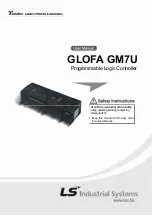ColdFire Core
MCF52110 ColdFire® Integrated Microcontroller Reference Manual, Rev. 1
Freescale Semiconductor
3-21
Preliminary
cycle, but rather calculates the vector number internally (vector number 12). Additionally, SR[M,I] are
unaffected by the interrupt.
3.3.4.10
RTE and Format Error Exception
When an RTE instruction is executed, the processor first examines the 4-bit format field to validate the
frame type. For a ColdFire core, any attempted RTE execution (where the format is not equal to {4,5,6,7})
generates a format error. The exception stack frame for the format error is created without disturbing the
original RTE frame and the stacked PC pointing to the RTE instruction.
The selection of the format value provides some limited debug support for porting code from M68000
applications. On M68000 family processors, the SR was located at the top of the stack. On those
processors, bit 30 of the longword addressed by the system stack pointer is typically zero. Thus, if an RTE
is attempted using this ‘old’ format, it generates a format error on a ColdFire processor.
If the format field defines a valid type, the processor: (1) reloads the SR operand, (2) fetches the second
longword operand, (3) adjusts the stack pointer by adding the format value to the auto-incremented address
after the fetch of the first longword, and then (4) transfers control to the instruction address defined by the
second longword operand within the stack frame.
3.3.4.11
TRAP Instruction Exception
The TRAP #n
instruction always forces an exception as part of its execution and is useful for implementing
system calls. The trap instruction may be used to change from user to supervisor mode.
3.3.4.12
Interrupt Exception
Interrupt exception processing includes interrupt recognition and the fetch of the appropriate vector from
the interrupt controller using an IACK cycle. See
Chapter 14, “Interrupt Controller Module”
for details on
the interrupt controller.
3.3.4.13
Fault-on-Fault Halt
If a ColdFire processor encounters any type of fault during the exception processing of another fault, the
processor immediately halts execution with the catastrophic fault-on-fault condition. A reset is required to
force the processor to exit this halted state.
3.3.4.14
Reset Exception
Asserting the reset input signal (RESET) to the processor causes a reset exception. The reset exception has
the highest priority of any exception; it provides for system initialization and recovery from catastrophic
failure. Reset also aborts any processing in progress when the reset input is recognized. Processing cannot
be recovered.
The reset exception places the processor in the supervisor mode by setting the SR[S] bit and disables
tracing by clearing the SR[T] bit. This exception also clears the SR[M] bit and sets the processor’s SR[I]
bit to the highest level (level 7, 0b111). Next, the VBR is initialized to zero (0x0000_0000). The control


















